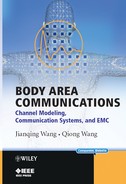Book Description
Providing an introduction to the fundamentals of body area communications, this book covers the key topics of channel modeling, modulation and demodulation, and performance evaluation
A systematic introduction to body area networks (BAN), this book focuses on three major parts: channel modeling, modulation/demodulation communications performance, and electromagnetic compatibility considerations. The content is logically structured to lead readers from an introductory level through to in-depth and more advanced topics.
Provides a concise introduction to this emerging topic based on classroom-tested materials
Details the latest IEEE 802.15.6 standard activities
Moves from very basic physics, to useful mathematic models, and then to practical considerations
Covers not only EM physics and communications, but also biological applications
Topics approached include: link budget, bit error rate performance, RAKE and diversity reception; SAR analysis for human safety evaluation; and modeling of electromagnetic interference to implanted cardiac pacemakers
Provides Matlab and Fortran programs for download from the Companion Website
Table of Contents
- Cover
- Title Page
- Copyright
- Preface
- Chapter 1: Introduction to Body Area Communications
- Chapter 2: Electromagnetic Characteristics of the Human Body
- Chapter 3: Electromagnetic Analysis Methods
- Chapter 4: Body Area Channel Modeling
- Chapter 5: Modulation/Demodulation
- Chapter 6: Body Area Communication Performance
- Chapter 7: Electromagnetic Compatibility Considerations
- Chapter 8: Summary and Future Challenges
- Index
